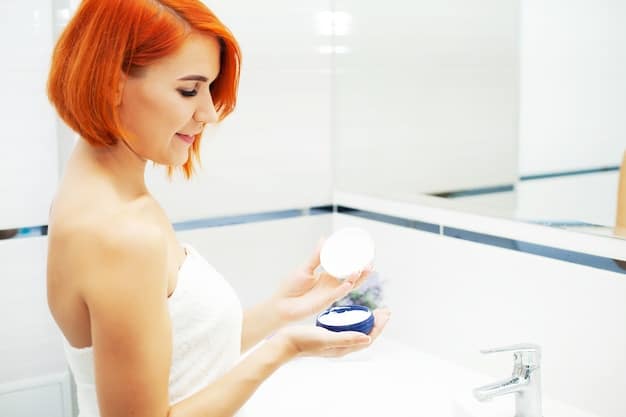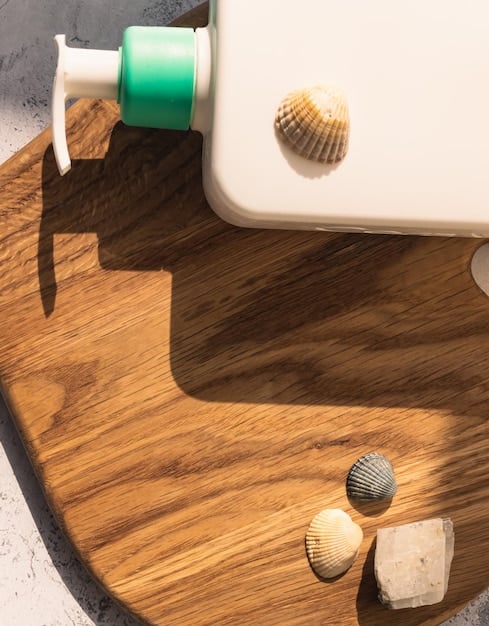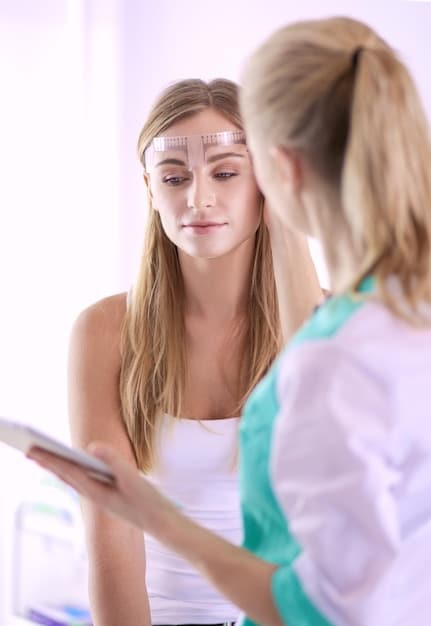How to Get Rid of Acne: Your Complete Guide to Clear Skin

How to get rid of acne involves a multifaceted approach including consistent skincare, targeted treatments, and lifestyle adjustments to manage oil production, reduce inflammation, and prevent future breakouts effectively, promoting clearer and healthier skin.
Dealing with acne can be frustrating, but understanding the causes and implementing the right strategies can make a significant difference. This guide, “**how to get rid of acne**,” provides a comprehensive overview of effective methods and practices to help you achieve clearer, healthier skin.
Understanding Acne: Causes and Types
Acne is a common skin condition that affects people of all ages. To effectively combat it, it’s crucial to understand what causes acne and the different types you might be experiencing.
Common Causes of Acne
Acne develops when hair follicles become clogged with oil and dead skin cells. Several factors contribute to this:
- Excess Oil Production: Overactive sebaceous glands produce too much oil, leading to clogged pores.
- Dead Skin Cells: Shedding dead skin cells can block pores if not properly cleared away.
- Bacteria: The bacteria Cutibacterium acnes can thrive in clogged pores, causing inflammation.
- Inflammation: Inflammation contributes to the formation of acne lesions, from small pimples to painful cysts.
Hormonal changes, diet, stress, and certain medications can also exacerbate acne.
Types of Acne
Acne manifests in various forms, each requiring different treatment approaches:
- Blackheads: Open comedones that appear black due to oxidation of the trapped oil and dead skin cells.
- Whiteheads: Closed comedones that appear as small, flesh-colored or white bumps.
- Papules: Small, red, inflamed bumps.
- Pustules: Papules with pus at their tips, often what people refer to as pimples.
- Nodules: Large, solid, painful lumps under the skin.
- Cysts: Painful, pus-filled lumps deep under the skin that can cause scarring.
Understanding the specific type of acne you’re dealing with is the first step in creating an effective treatment plan.
In summary, acne arises from a combination of factors including oil production, dead skin cells, bacteria, and inflammation. Recognizing the type of acne present helps in choosing the most appropriate treatments.
Establishing a Consistent Skincare Routine
A consistent skincare routine is foundational to **how to get rid of acne**. It involves cleansing, treating, and protecting your skin daily.
Cleansing: The First Step
Cleansing your face twice a day helps remove excess oil, dirt, and dead skin cells that can clog pores. Use a gentle, non-comedogenic cleanser to avoid irritation.
Look for ingredients like salicylic acid or benzoyl peroxide, which can help exfoliate and kill bacteria.
Treatment: Targeted Solutions
After cleansing, apply targeted treatments to address specific acne concerns. Common treatment options include:
- Topical Retinoids: These help unclog pores and reduce inflammation.
- Benzoyl Peroxide: Kills acne-causing bacteria.
- Salicylic Acid: Exfoliates the skin and unclogs pores.
- Azelaic Acid: Reduces inflammation and has antibacterial properties.
Start with a low concentration and gradually increase as your skin tolerates it to minimize irritation.
Moisturizing and Sun Protection
Even if you have oily skin, moisturizing is essential to keep your skin hydrated and prevent it from overproducing oil. Choose a non-comedogenic moisturizer.
Sunscreen is equally important, as some acne treatments can make your skin more sensitive to the sun. Use a broad-spectrum sunscreen with an SPF of 30 or higher.

By establishing a consistent skincare routine that includes cleansing, treatment, moisturizing, and sun protection, you can effectively manage acne and promote healthier skin.
Over-the-Counter (OTC) Treatments
Many effective treatments are available over-the-counter to help **how to get rid of acne**. These products often contain active ingredients that target different aspects of acne development.
Key Ingredients to Look For
When choosing OTC acne treatments, consider products that contain the following ingredients:
- Benzoyl Peroxide: Effective for killing acne-causing bacteria, reducing inflammation, and unclogging pores.
- Salicylic Acid: Helps exfoliate the skin, unclog pores, and reduce inflammation.
- Alpha Hydroxy Acids (AHAs): Like glycolic acid and lactic acid, AHAs exfoliate the skin and help improve its texture.
- Tea Tree Oil: A natural antibacterial and anti-inflammatory agent.
Read product labels carefully and choose products that are appropriate for your skin type and the severity of your acne.
Product Types
OTC acne treatments come in various forms, including:
- Cleansers: Use daily to remove dirt and oil.
- Spot Treatments: Apply directly to individual pimples to reduce inflammation and promote healing.
- Gels and Creams: Apply to larger areas to treat and prevent breakouts.
- Pads and Wipes: Convenient for on-the-go treatment and exfoliation.
Experiment with different product types to find what works best for your skin.
How to Use OTC Treatments
Follow the instructions on the product label carefully. Start with a small amount and gradually increase usage as your skin tolerates it. Be patient, as it may take several weeks to see noticeable improvements. If irritation occurs, reduce frequency or discontinue use.
Using OTC treatments with key ingredients like benzoyl peroxide and salicylic acid, in various forms such as cleansers and spot treatments, can effectively manage mild to moderate acne. Always follow product instructions and monitor your skin’s response.
Prescription Medications for Acne
For more severe or persistent acne, prescription medications may be necessary to **how to get rid of acne**. A dermatologist can assess your skin and recommend the most appropriate treatment options.

Types of Prescription Medications
Common prescription medications for acne include:
- Topical Retinoids: Stronger versions of OTC retinoids, such as tretinoin, adapalene, and tazarotene, can effectively unclog pores and reduce inflammation.
- Topical Antibiotics: Reduce bacteria and inflammation. Often used in combination with benzoyl peroxide to prevent antibiotic resistance.
- Oral Antibiotics: Such as doxycycline and minocycline, can help reduce bacteria and inflammation throughout the body. Typically used for a limited time to avoid long-term side effects.
- Isotretinoin: A powerful oral medication that reduces oil production, unclogs pores, and reduces inflammation. Reserved for severe acne cases due to potential side effects.
- Birth Control Pills: Can help regulate hormones and reduce acne in women.
- Spironolactone: An anti-androgen medication that can help reduce oil production and acne in women.
Your dermatologist will consider your specific type of acne, skin type, and medical history when prescribing medication.
Important Considerations
Prescription acne medications can have side effects, so it’s essential to discuss these with your doctor. Common side effects include dryness, irritation, sun sensitivity, and, in the case of isotretinoin, more severe risks such as birth defects.
Regular follow-up appointments with your dermatologist are crucial to monitor your progress and adjust your treatment plan as needed.
Prescription medications, including topical and oral options, offer a more powerful approach for managing severe acne, but they require careful consideration of potential side effects and ongoing monitoring by a dermatologist.
Lifestyle Changes and Home Remedies
In addition to skincare and medications, lifestyle changes and home remedies can support **how to get rid of acne**. These practices focus on reducing inflammation and promoting overall skin health.
Dietary Considerations
While diet’s role in acne is debated, some studies suggest that certain foods can exacerbate acne. Consider the following:
- Limit Sugary Foods and Drinks: High-glycemic foods can increase inflammation and oil production.
- Avoid Dairy: Some people find that dairy products worsen their acne.
- Incorporate Anti-Inflammatory Foods: Foods rich in omega-3 fatty acids, antioxidants, and probiotics may help reduce inflammation.
Pay attention to how your skin reacts to different foods and adjust your diet accordingly.
Stress Management
Stress can trigger hormonal changes that lead to acne breakouts. Practice stress-reducing activities such as:
- Exercise: Regular physical activity can improve circulation and reduce stress.
- Meditation: Mindfulness and meditation can help calm the mind and reduce stress hormones.
- Sufficient Sleep: Aim for 7-9 hours of sleep per night to support overall health and reduce stress.
Finding healthy ways to manage stress can significantly impact your skin health.
Home Remedies
Several home remedies may help reduce acne symptoms:
- Tea Tree Oil: Diluted tea tree oil can be applied to individual pimples to reduce inflammation and kill bacteria.
- Aloe Vera: Soothes irritated skin and promotes healing.
- Honey: Has antibacterial and anti-inflammatory properties.
Always test home remedies on a small area of skin first to ensure you don’t have an allergic reaction.
Lifestyle adjustments such as diet modification and stress management, combined with gentle home remedies, can complement your skincare routine and promote clearer skin.
Preventing Future Breakouts
Preventing future breakouts is just as important as treating existing acne to **how to get rid of acne**. Establishing long-term habits can help keep your skin clear and healthy.
Maintaining a Consistent Routine
Stick to your skincare routine even when your skin is clear. Consistency is key to preventing new breakouts.
Avoid picking or squeezing pimples, as this can lead to inflammation, scarring, and further breakouts.
Choosing the Right Products
Use non-comedogenic skincare and makeup products to prevent clogged pores. Look for products labeled “oil-free” and “non-acnegenic.”
Clean your makeup brushes regularly to prevent the buildup of bacteria.
Regular Exfoliation
Exfoliate your skin 1-2 times a week to remove dead skin cells and prevent clogged pores. Use a gentle exfoliator to avoid irritation.
Consider using chemical exfoliants like AHAs or BHAs for a deeper exfoliation.
Adopting preventative measures such as maintaining a consistent routine, using the right products, and regular exfoliation can help keep acne at bay and promote long-term skin health.
| Key Point | Brief Description |
|---|---|
| 🧼 Consistent Skincare | Cleanse, treat, and protect daily. |
| 🧴 OTC Treatments | Use benzoyl peroxide or salicylic acid. |
| 💊 Prescription Meds | Consult a dermatologist for severe acne. |
| 🌱 Lifestyle & Diet | Manage stress, limit sugar and dairy. |
Frequently Asked Questions (FAQ)
▼
Start with a gentle, consistent skincare routine. Use a mild cleanser twice a day, followed by a non-comedogenic moisturizer. Add an OTC treatment with salicylic acid or benzoyl peroxide to target acne.
▼
It typically takes 6-8 weeks to see noticeable improvements. Acne treatments require patience and consistency. If there’s no improvement after that period, consider consulting a dermatologist.
▼
Yes, diet can influence acne. High-glycemic foods and dairy products may worsen acne for some individuals. A balanced diet with anti-inflammatory foods may help reduce breakouts.
▼
Side effects vary. Topical retinoids may cause dryness and irritation. Oral antibiotics can lead to digestive issues. Isotretinoin has more severe risks, including birth defects, requiring close monitoring.
▼
Avoid picking or squeezing pimples, which can cause inflammation and scarring. Use sunscreen to protect acne lesions from darkening. Consult a dermatologist for treatments like chemical peels or laser therapy for existing scars.
Conclusion
Dealing with acne requires a comprehensive approach that combines consistent skincare, targeted treatments, lifestyle adjustments, and preventative measures. Whether you’re using over-the-counter products, prescription medications, or home remedies, understanding your skin and being patient is key to achieving clearer, healthier skin.





